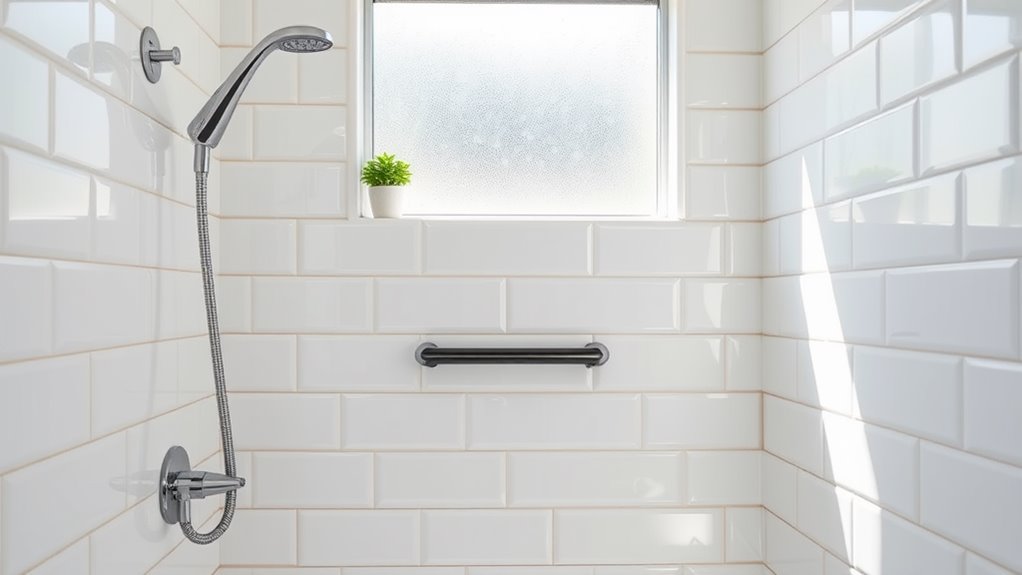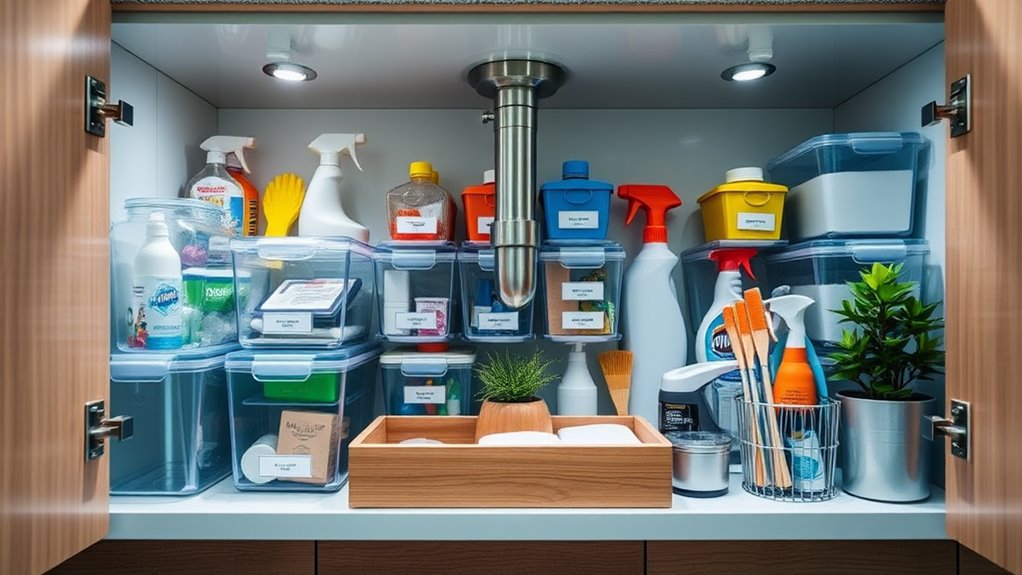The Easiest Way to Keep Shower Tiles Mold-Free All Year
To keep your shower tiles mold-free year-round, start by wiping them down after each use to remove excess water. Use a squeegee or microfiber cloth for best results. Guarantee good ventilation by running an exhaust fan during and after showers, and keep humidity levels below 50%. Regular cleaning with vinegar or baking soda prevents mold buildup. Selecting mold-resistant materials also helps. You’ll discover more tips to maintain a mold-free shower environment effortlessly.
Key Takeaways
- Wipe down shower tiles with a squeegee or microfiber cloth after each use to eliminate excess moisture.
- Ensure proper ventilation by using an exhaust fan during and after showers to reduce humidity levels.
- Use a vinegar and water solution weekly to clean tiles and prevent mold from taking hold.
- Inspect and maintain grout and caulking regularly, replacing any damaged areas promptly to block moisture entry.
- Choose mold-resistant materials like porcelain tiles and glass to minimize the risk of mold growth.
Understanding Mold Growth in Showers
[Mold thrives in moist environments, which is why showers are a prime breeding ground for it. When you shower, steam and water create the perfect conditions for shower mold to flourish. The prevention methods outlined in this guide can help you maintain a mold-free environment. Regularly cleaning surfaces and ensuring proper ventilation can further inhibit mold growth.]
The combination of warmth and humidity allows mold spores to settle on tiles, grout, and caulking, leading to unsightly stains and potential health issues. Understanding this growth cycle is vital for maintaining clean tiles. Mold can start to develop within 24 to 48 hours if the environment remains damp. It’s essential to recognize the signs early—watch for discoloration or a musty smell. Implementing preventive measures can significantly reduce the likelihood of mold growth and maintain a healthier bathroom environment. Regularly using a DIY cleaning solution made from common household ingredients can further enhance your mold prevention efforts. Additionally, utilizing natural cleaning ingredients can effectively combat existing mold and prevent future outbreaks.
Daily Habits to Prevent Mold
To keep your shower tiles mold-free, cultivating daily habits makes a significant difference.
Implementing these practices will help you maintain a clean and mold-free environment:
-
Wipe down tiles after each shower: Use a squeegee or towel to remove excess water. This simple step can significantly reduce the chances of mold growth.
-
Ventilate your bathroom: Open windows or use an exhaust fan to reduce humidity, as high humidity levels can promote mold growth. Proper ventilation also helps to maintain fresh air in the bathroom, preventing musty odors. Additionally, proper ventilation techniques are essential for minimizing moisture accumulation.
-
Keep shower items organized: Store products in a well-ventilated area to prevent moisture buildup. Keeping these items tidy can also enhance the effectiveness of your cleaning routine.
-
Monitor for leaks: Regularly check for plumbing issues that can contribute to water accumulation.
-
Consider using an anti-mold spray: These products can enhance your cleaning efforts and maintain a hygienic bathroom environment. Opting for natural alternatives can further help in keeping your space fresh. Additionally, using a simple spray solution can make cleaning easier and more effective.
Effective Cleaning Solutions
To keep your shower tiles pristine, start with a mixture of equal parts vinegar and water. Spray it generously on tiles, let it sit for a few minutes, and then scrub with a soft brush. Vinegar is a natural eco-friendly cleaner that effectively eliminates mold and mildew, making it an excellent choice for maintaining a healthy bathroom environment. Additionally, embracing natural cleaners can lead to a safer cleaning experience for both you and the environment. Using natural ingredients in your cleaning routine can enhance the effectiveness of your efforts.
For tougher stains, a paste of baking soda and water can work wonders; apply it directly, let it dry, and scrub it off. Don’t overlook commercial mold removers, either—just verify they’re safe for your tile type. After cleaning, rinse thoroughly to remove all residues. For an added layer of protection, consider sealing your grout every year to prevent future buildup of mold and mildew. Additionally, using eco-friendly bathroom cleaners not only helps maintain cleanliness but also reduces your environmental impact.
With these effective cleaning solutions, you’ll maintain a mold-free environment effortlessly.
The Role of Ventilation
Good ventilation is key to keeping your shower tiles mold-free.
By ensuring fresh air circulates, you can effectively control humidity levels and reduce the chances of mold growth.
Let’s explore some simple tips to improve airflow in your bathroom.
Importance of Fresh Air
While you may not realize it, proper ventilation plays an essential role in keeping your shower tiles mold-free. Fresh air circulation prevents moisture buildup, which is a breeding ground for mold. By ensuring your bathroom is well-ventilated, you can greatly reduce the risk of mold development.
Here are some key benefits of fresh air:
-
Reduces humidity levels: Lower moisture means less chance for mold to thrive.
-
Improves air quality: Fresh air helps eliminate musty odors and stale air.
-
Enhances comfort: A well-ventilated space feels more inviting and less stuffy.
-
Promotes longevity: Proper airflow extends the life of your tiles and grout.
Humidity Control Tips
To keep humidity levels in check, you need to prioritize proper ventilation in your bathroom.
Start by installing a high-quality exhaust fan. Make sure it’s powerful enough to expel the moist air quickly; aim for a fan that can exchange the air in the room at least eight times per hour.
Always run the fan during and for at least 30 minutes after your shower. If possible, crack a window open to enhance airflow, especially during warmer months.
Additionally, consider using a dehumidifier if your bathroom lacks adequate ventilation. Regularly clean the fan and verify that the ductwork is unobstructed to maximize efficiency.
Mastering these ventilation tips will appreciably reduce humidity, preventing mold growth and keeping your tiles pristine.
Choosing Mold-Resistant Materials
When you’re selecting materials for your shower tiles, opting for mold-resistant options can greatly reduce the risk of future growth.
You’ll want to focus on materials that naturally repel moisture and inhibit mold formation. Consider these choices:
-
Porcelain Tiles: Highly dense and virtually non-porous.
-
Glass Tiles: Smooth surface that prevents mold adhesion.
-
Natural Stone with Sealant: Treated to resist moisture absorption.
-
Vinyl Flooring: Water-resistant and easy to clean.
Regular Maintenance Routines
Regular maintenance routines are essential for keeping your shower tiles mold-free and in top condition.
Start by wiping down your tiles after each use to remove excess moisture. Use a squeegee or a microfiber cloth to prevent water buildup, which promotes mold growth.
Schedule a weekly thorough cleaning with a mild, non-toxic cleaner designed for tile surfaces. Pay close attention to grout lines, as they’re often mold’s favorite hiding spots.
Additionally, inspect your caulking regularly; replace any damaged areas promptly to prevent moisture penetration.
Finally, maintain proper ventilation in your bathroom by using exhaust fans or opening windows during and after showers.
These simple yet effective habits will fortify your tiles against mold year-round.
Using Natural Remedies
If you’re looking for eco-friendly solutions to keep your shower tiles mold-free, natural remedies can be highly effective.
These alternatives not only combat mold but also promote a healthier living environment. Here are some powerful options you can easily incorporate:
-
Vinegar: Spray undiluted white vinegar on tiles; let it sit for an hour before rinsing.
-
Baking Soda: Create a paste with water, apply it to affected areas, and scrub gently.
-
Tea Tree Oil: Mix a few drops with water in a spray bottle; mist tiles and let it air dry.
-
Lemon Juice: Use lemon juice as a natural cleaner; its acidity helps eliminate mold spores.
These remedies offer a simple way to maintain your shower’s cleanliness while being kind to the environment.
Monitoring Humidity Levels
To keep your shower tiles mold-free, it’s essential to monitor humidity levels consistently, as high humidity can create the perfect breeding ground for mold.
Invest in a hygrometer to track the moisture in your bathroom. Ideally, humidity should stay below 50%. If you notice levels exceeding this, act quickly. Open windows or use exhaust fans to enhance ventilation during and after showers. You can also leave the bathroom door open to promote airflow.
If mold does appear, address it immediately with appropriate cleaning solutions. Regularly monitoring and controlling humidity not only protects your tiles but also promotes a healthier environment.
Frequently Asked Questions
Can I Use Bleach to Clean Moldy Shower Tiles?
Yes, you can use bleach to clean moldy shower tiles. It effectively kills mold, but make sure to ventilate the area and wear gloves. Rinse thoroughly afterward to prevent damage to your tiles and grout.
What Are the Best Tools for Cleaning Shower Tiles?
For cleaning shower tiles effectively, you’ll want a stiff-bristle brush, a spray bottle for your cleaning solution, and microfiber cloths. These tools help you tackle grime and maintain a sparkling, mold-free surface with ease.
How Often Should I Deep Clean My Shower?
You should deep clean your shower at least once a month. Regular maintenance keeps mold at bay and guarantees your tiles remain fresh. Don’t forget to check for buildup between deep cleans for ideal results.
Does Hard Water Contribute to Mold Growth?
Yes, hard water can contribute to mold growth. The minerals in hard water create a slippery surface, making it easier for mold to thrive. Regular cleaning helps combat this issue and keeps your tiles mold-free.
Can I Prevent Mold With Essential Oils?
Yes, you can prevent mold with essential oils. Oils like tea tree and lavender have antifungal properties. Mix them with water in a spray bottle, and apply them regularly to keep your surfaces mold-free.



